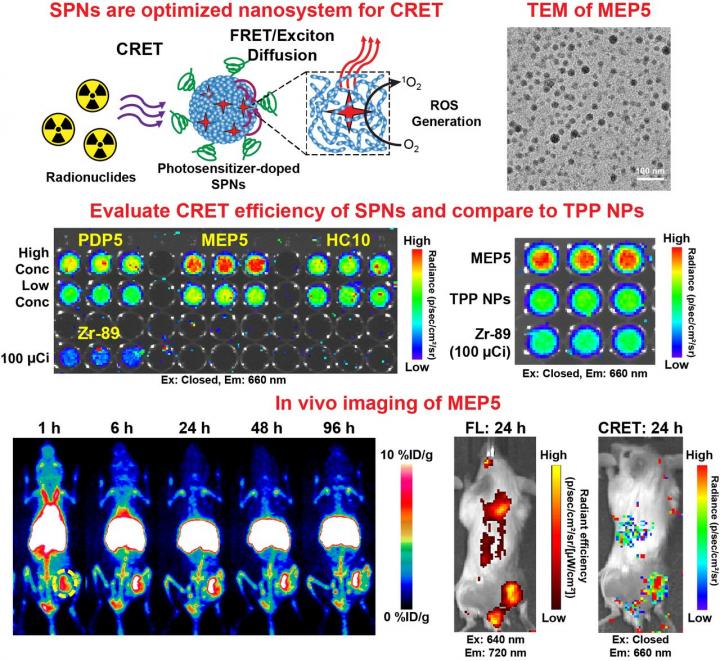PET Imaging Reveals Efficacy of Novel Cancer Treatment
New therapy uses light from decaying radiopharmaceuticals to attack cancer cells from inside the body.
Using PET imaging, as well as optical imaging, can help providers visualize the effectiveness of a new cancer treatment approach that uses Cerenkov radiation energy in a different way.
In a presentation during the Society of Nuclear Medicine and Molecular Imaging 2021 Annual Meeting, researchers from the University of Wisconsin-Madison revealed that the light from decaying radiopharmaceuticals, known as Cerenkov luminescence, can be an internal energy source that activates semi-conducting polymer nanoparticles to target and attack cancer.
For more SNMMI 2021 coverage, click here.
Photodynamic therapy, the use of external light to activate nanomaterials for cancer treatment, isn’t new, but it is limited. Its efficacy is capped by its ability to penetrate tissue. Using Cerenkov luminescence is an effective alternative, the investigators said, because it spontaneously erupts as certain radiopharmaceuticals decay in the body, meaning it can fight cancer from the inside.
The light source itself is generally weak, but there are ways to strengthen it.
“The good news is that the light source can be amplified with semi-conducting polymers, which greatly increases its potential to target and destroy cancer cells,” said Zachary Rosenkrans, a University of Wisconsin-Madison graduate research assistant. “In our study, we aimed to determine how to best utilize radiopharmaceuticals and nanoparticles to create the ideal cancer theranostics nanosystem.”
Semiconducting polymer nanoparticles amplify and harness Cerenkov luminescence for cancer theranostics.
Credit: Image created by ZT Rosenkrans, et al. University of Wisconsin-Madison, Madison, WI.

In their study, the team discovered that using semi-conducting polymer nanoparticles that are optimized with photosensitizers dramatically intensifies Cerenkov luminescence’s ability to kill cancer cells. Using PET and optical imaging, they were able to see clear tumor uptake of the optimized nanoparticles.
Based on these results, Rosenkrans said, this approach has substantial potential as a cancer theranostics nanosystem without any tissue penetration limits.
“This work is an important step toward translating nanomaterials that are activated by light, using radiopharmaceuticals as an activation source,” Rosenkrans said. “The basic concept, using semi-conducting polymers to harness and amplify light produced from radiopharmaceuticals, is also very exciting and could have many interesting applications in the future.”
For more coverage based on industry expert insights and research, subscribe to the Diagnostic Imaging e-Newsletter here.
Can CT-Based AI Radiomics Enhance Prediction of Recurrence-Free Survival for Non-Metastatic ccRCC?
April 14th 2025In comparison to a model based on clinicopathological risk factors, a CT radiomics-based machine learning model offered greater than a 10 percent higher AUC for predicting five-year recurrence-free survival in patients with non-metastatic clear cell renal cell carcinoma (ccRCC).
The Reading Room: Racial and Ethnic Minorities, Cancer Screenings, and COVID-19
November 3rd 2020In this podcast episode, Dr. Shalom Kalnicki, from Montefiore and Albert Einstein College of Medicine, discusses the disparities minority patients face with cancer screenings and what can be done to increase access during the pandemic.
FDA Clears AI Assessment of Ischemic Core Volume on CT with Brainomix 360 Platform
April 8th 2025For patients with acute ischemic stroke, research has demonstrated that automated assessment of ischemic core volume on brain CT scans via the Brainomix 360 software is equivalent to that derived from CT perfusion.
Study with CT Data Suggests Women with PE Have More Than Triple the One-Year Mortality Rate than Men
April 3rd 2025After a multivariable assessment including age and comorbidities, women with pulmonary embolism (PE) had a 48 percent higher risk of one-year mortality than men with PE, according to a new study involving over 33,000 patients.